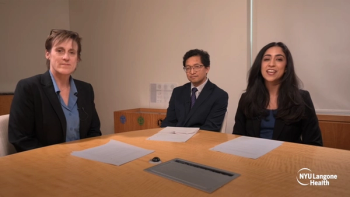
Canaloplasty safely enhances aqueous outflow
Sacramento, CA-Dilation of Schlemm's canal to 360? and use of a tension suture result in significantly decreased postoperative IOP levels, said Richard A. Lewis, MD, who is in private practice here. The procedure, canaloplasty, safely enhances aqueous outflow in patients with primary open-angle glaucoma (POAG), said Dr. Lewis, reporting the findings of an ongoing prospective multi-site study being conducted in the United States, the European Union, and South Africa.
"Surgical manipulation of Schlemm's canal and the collector system to control IOP has long been a goal in glaucoma," Dr. Lewis said.
As with every surgical intervention, canaloplasty has its pros and cons. On the plus side, it is a nonpenetrating procedure, it eliminates the early and late complications associated with trabeculectomy, it involves no blebs or bleb-related problems, and no hypotony develops, Dr. Lewis said.
"The technology allows in vivo examination of the human outflow system. The canal in POAG is often collapsed in these patients, and the technology aids in the differential diagnosis," Dr. Lewis said.
During surgery, the system can identify the location of the canal preoperatively to facilitate creation of the incision, and the surgical findings can be confirmed postoperatively.
Another recent advance is the ability to cannulate the canal. A flexible microcannula (iTrack 250A, iScience Interventional) with a lighted beacon has been developed. This microcannula dilates the entire 360° of the canal and collectors with a viscoelastic agent, he said, and it allows passage of sutures or a stent to maintain the patency of the canal.
Canaloplasty study
Dr. Lewis and colleagues conducted a study to determine the efficacy and side effects of canaloplasty after following patients for 6 months postoperatively. All patients had open-angle glaucomas that included POAG, pseudoexfoliation, or pigment dispersion syndrome and an IOP that exceeded 21 mm Hg. Patient were excluded if they had angle closure or peripheral anterior synechia in the angle, secondary glaucoma, had undergone a previous surgery in or around Schlemm's canal, had more than one argon laser trabeculoplasty or selective laser trabeculoplasty, or had postoperative blebs.
The surgical procedure involves insertion of a microcatheter into Schlemm's canal from a scleral cut-down. Viscoelastic then is injected to dilate the canal and the collector channels. After 360° catheterization of the canal, the microcatheter is used to pull a polypropylene suture (Prolene, Ethicon Inc.) into the canal. The ends of the suture then are tied to provide tension to the trabecular meshwork and maintain a patent canal lumen. The scleral flap is sutured to avoid bleb formation, Dr. Lewis said.
He reported on the results of canaloplasty in the United States and European Union. A total of 133 patients were enrolled (average age, 68.0 years; range, 43 to 89 years). The average maximum IOP in these patients was 27.9 mm Hg (range, 17 to 46 mm Hg). The patients used an average of 2.1 anti-glaucoma medications preoperatively.
A total of 117 patients (88%) underwent 360° cannulation; 99 patients (77%) of the 117 had implantation of tension sutures, and 31 (31%) of the 99 patients had combined procedures.
Preoperatively, in those 99 patients, mean IOP was 23.3 mm Hg (range, 10 to 52 mm Hg), and the mean number of anti-glaucoma medications taken was 2.1.
Postoperative results
Newsletter
Don’t miss out—get Ophthalmology Times updates on the latest clinical advancements and expert interviews, straight to your inbox.













































